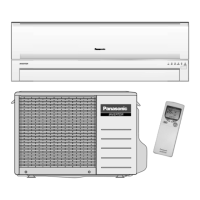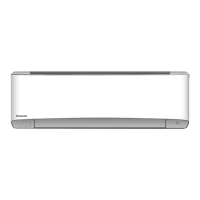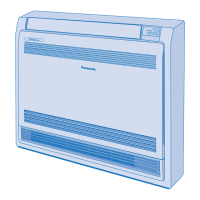Do you have a question about the Panasonic CU-E9MKE-3 and is the answer not in the manual?
Explains how multi air conditioner systems connect multiple indoor units to a single outdoor unit to save space.
Specifies operating temperature ranges for cooling and heating for single split outdoor units.
Specifies operating temperature ranges for cooling and heating for multi split outdoor units.
Explains warning symbols, cautions, and general safety rules for unit operation.
Covers safety for indoor/outdoor units, remote control, and power supply to prevent hazards.
Focuses on specific safety measures for power supply, unit operation, and electrical hazard prevention.
Provides guidelines for remote control battery use, unit maintenance, and handling environmental factors.
Instructions for turning the unit on/off and setting the desired temperature using the remote control.
Details how to select operating modes (Auto, Heat, Cool, Dry) and adjust fan speed with the remote.
Explains how to control the airflow direction and activate air swing features using the remote control.
Describes features for clean air (e-ion) and humidity management during cooling.
Explains how to use Powerful/Quiet modes for quick temperature adjustment and ECONAVI for energy saving.
Details the ECONAVI feature that uses sensors to optimize temperature and airflow based on human presence.
Instructions on how to set up to two sets of ON and OFF timers for automated operation.
Guidance on retrieving error codes using the remote control to diagnose unit issues.
Guidelines for cleaning the indoor unit, including safe cleaning agents and methods.
Identifies and describes the function of major indoor unit parts like sensors, louvers, and filters.
Details the e-ion air purifying system, filters, charging wire, and generator cleaning.
Lists symptoms that may appear normal but do not indicate a malfunction, with their causes.
Provides a checklist of common issues and checks to perform before contacting a service agent.
Offers advice for seasonal inspection after non-use and preparations for extended periods of non-operation.
Lists criteria that require contacting an authorized dealer for service instead of attempting self-repair.
Provides guidance on the proper collection and disposal of old electrical equipment and used batteries.
Explains how multi air conditioner systems connect multiple indoor units to a single outdoor unit to save space.
Specifies operating temperature ranges for cooling and heating for single split outdoor units.
Specifies operating temperature ranges for cooling and heating for multi split outdoor units.
Explains warning symbols, cautions, and general safety rules for unit operation.
Covers safety for indoor/outdoor units, remote control, and power supply to prevent hazards.
Focuses on specific safety measures for power supply, unit operation, and electrical hazard prevention.
Provides guidelines for remote control battery use, unit maintenance, and handling environmental factors.
Instructions for turning the unit on/off and setting the desired temperature using the remote control.
Details how to select operating modes (Auto, Heat, Cool, Dry) and adjust fan speed with the remote.
Explains how to control the airflow direction and activate air swing features using the remote control.
Describes features for clean air (e-ion) and humidity management during cooling.
Explains how to use Powerful/Quiet modes for quick temperature adjustment and ECONAVI for energy saving.
Details the ECONAVI feature that uses sensors to optimize temperature and airflow based on human presence.
Instructions on how to set up to two sets of ON and OFF timers for automated operation.
Guidance on retrieving error codes using the remote control to diagnose unit issues.
Guidelines for cleaning the indoor unit, including safe cleaning agents and methods.
Identifies and describes the function of major indoor unit parts like sensors, louvers, and filters.
Details the e-ion air purifying system, filters, charging wire, and generator cleaning.
Lists symptoms that may appear normal but do not indicate a malfunction, with their causes.
Provides a checklist of common issues and checks to perform before contacting a service agent.
Offers advice for seasonal inspection after non-use and preparations for extended periods of non-operation.
Lists criteria that require contacting an authorized dealer for service instead of attempting self-repair.
Provides guidance on the proper collection and disposal of old electrical equipment and used batteries.
| Cooling Capacity | 2.5 kW |
|---|---|
| Heating Capacity | 3.2 kW |
| Refrigerant | R32 |
| Coefficient of Performance (COP) | 3.61 |
| Indoor Unit Weight | 9 kg |
| Type | Split Type |
| Power Supply | 50 Hz |
| Outdoor Unit Noise Level | 47 dB |












